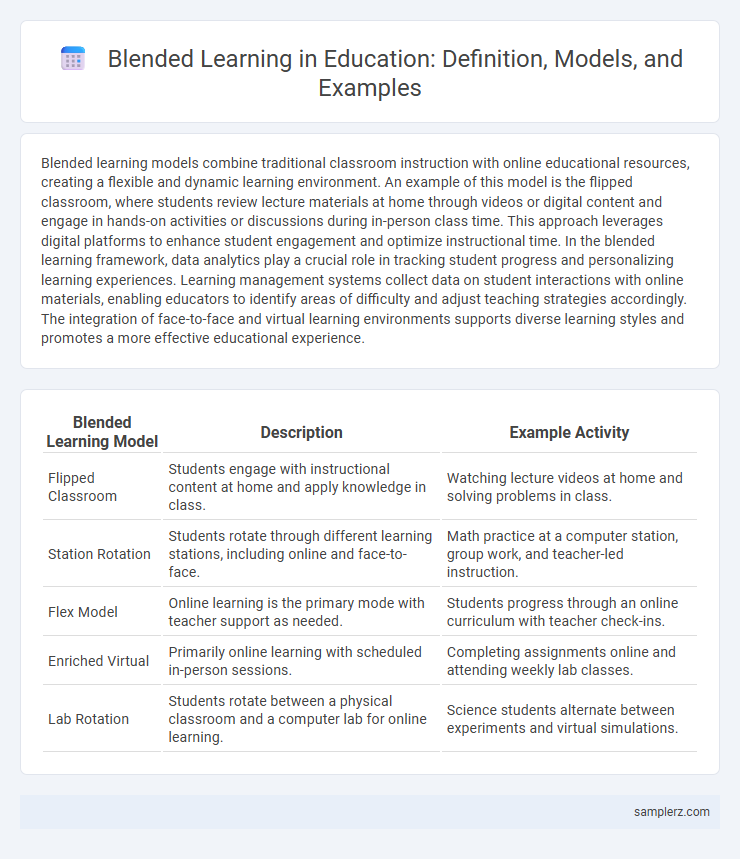Blended learning models combine traditional classroom instruction with online educational resources, creating a flexible and dynamic learning environment. An example of this model is the flipped classroom, where students review lecture materials at home through videos or digital content and engage in hands-on activities or discussions during in-person class time. This approach leverages digital platforms to enhance student engagement and optimize instructional time. In the blended learning framework, data analytics play a crucial role in tracking student progress and personalizing learning experiences. Learning management systems collect data on student interactions with online materials, enabling educators to identify areas of difficulty and adjust teaching strategies accordingly. The integration of face-to-face and virtual learning environments supports diverse learning styles and promotes a more effective educational experience.
Table of Comparison
| Blended Learning Model | Description | Example Activity |
|---|---|---|
| Flipped Classroom | Students engage with instructional content at home and apply knowledge in class. | Watching lecture videos at home and solving problems in class. |
| Station Rotation | Students rotate through different learning stations, including online and face-to-face. | Math practice at a computer station, group work, and teacher-led instruction. |
| Flex Model | Online learning is the primary mode with teacher support as needed. | Students progress through an online curriculum with teacher check-ins. |
| Enriched Virtual | Primarily online learning with scheduled in-person sessions. | Completing assignments online and attending weekly lab classes. |
| Lab Rotation | Students rotate between a physical classroom and a computer lab for online learning. | Science students alternate between experiments and virtual simulations. |
Introduction to Blended Learning Models
Blended learning models integrate traditional face-to-face instruction with online educational resources to enhance student engagement and flexibility. The Station Rotation model allows students to rotate through various learning stations, combining online activities with direct teacher interaction. This approach supports differentiated instruction by tailoring content to diverse learning styles and pacing.
Flipped Classroom as a Blended Learning Example
The Flipped Classroom model exemplifies blended learning by reversing traditional teaching methods, where students first engage with new content online at home and then participate in interactive, collaborative activities in the classroom. This approach enhances student-centered learning, fosters critical thinking, and maximizes face-to-face classroom time for application and discussion. Research indicates that the Flipped Classroom improves academic performance and increases student engagement by combining digital resources with active, in-person instruction.
Rotation Model in Blended Learning
The Rotation Model in blended learning integrates face-to-face classroom instruction with online learning activities, allowing students to rotate between different modalities on a fixed schedule or at the teacher's discretion. This model includes several sub-models such as station rotation, lab rotation, and flipped classroom, each designed to optimize student engagement and personalized learning. Research shows that the Rotation Model enhances student outcomes by fostering collaboration, immediate feedback, and self-paced learning environments.
Flex Model: Personalized Learning Paths
The Flex Model in blended learning allows students to follow personalized learning paths through a combination of online content and face-to-face support, enabling customization based on individual progress and needs. Digital platforms deliver core instruction while teachers provide on-demand assistance, fostering self-paced mastery of subjects such as mathematics or language arts. This approach enhances student engagement and accommodates diverse learning styles within a flexible educational framework.
Enriched Virtual Model Applications
The Enriched Virtual Model in blended learning combines online instruction with face-to-face sessions, enabling students to access digital content independently while participating in scheduled in-person activities. Applications of this model include virtual labs in STEM education, where learners engage with interactive simulations online and attend hands-on workshops to reinforce concepts. This approach enhances flexibility and personalized learning, promoting deeper understanding and improved academic outcomes.
Lab Rotation in Blended Learning
Lab Rotation in blended learning integrates traditional classroom instruction with hands-on lab sessions, rotating students through various workstations to enhance experiential learning. This model optimizes personalized education by allowing students to engage in collaborative projects, virtual simulations, and direct experimentation in STEM subjects. Emphasizing technology and face-to-face interaction, Lab Rotation increases student engagement and improves competency in practical skills.
Station Rotation in K-12 Education
Station Rotation is a popular blended learning model in K-12 education where students cycle through various learning stations, including online learning, collaborative activities, and teacher-led instruction. This approach allows personalized learning pacing and leverages technology to enhance student engagement and mastery of subjects like math and reading. Schools implementing Station Rotation report improved student outcomes due to the balanced integration of digital tools and face-to-face support.
Project-Based Blended Learning
Project-Based Blended Learning integrates online digital tools with hands-on classroom projects, enhancing critical thinking and collaboration skills. Students use virtual platforms to research, plan, and receive feedback while applying concepts through real-world projects in physical settings. This model fosters deeper understanding by connecting theoretical knowledge with practical application, improving engagement and retention rates in various educational levels.
Self-Directed Online and In-Person Learning
Blended learning models combine self-directed online modules with structured in-person sessions, allowing students to progress at their own pace while benefiting from direct teacher feedback. Platforms like Khan Academy or Coursera offer adaptive online resources that complement classroom discussions, fostering a personalized learning experience. This approach enhances engagement and retention by integrating digital content with face-to-face interaction in curriculum design.
Case Studies of Blended Learning Success
Case studies of blended learning success highlight Arizona State University's comprehensive integration of online digital media with traditional face-to-face instruction, resulting in improved student engagement and academic performance. At the University of Central Florida, the hybrid model combining synchronous virtual sessions and in-person labs led to increased retention rates and learner satisfaction. These examples demonstrate the effectiveness of blending technology-enhanced learning environments with conventional teaching methods for optimizing educational outcomes.

example of blended learning in model Infographic
 samplerz.com
samplerz.com